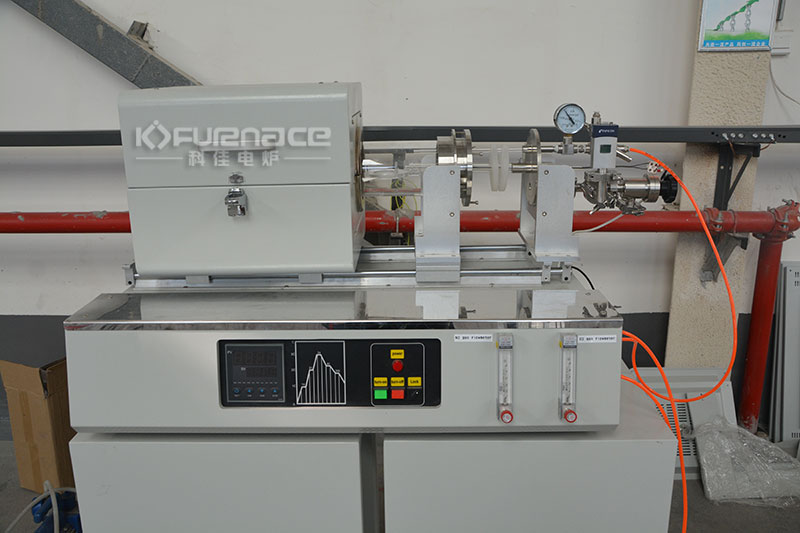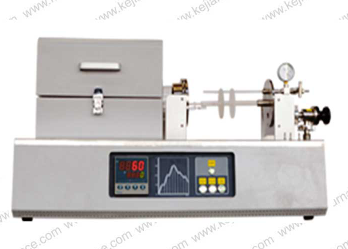The rapid annealing RTP tube furnace is a commonly used equipment that combines rapid heat treatment (RTP) technology with tube furnace structure. Its core is to achieve rapid temperature rise and fall of the sample through high-power heat sources (such as halogen lamps and infrared lamps), while ensuring the quality of heat treatment by utilizing the uniform heating environment of the tube furnace. Let’s take a detailed look below!

Commonly used RTP fast annealing furnace (click on the image to view product details)
1. Technical principle: Integration of rapid temperature rise and uniform heating
Rapid heating mechanism
High power halogen lamps or infrared lamps are used as heat sources, which directly act on the surface of the sample through radiative heat transfer, achieving a heating rate of tens to hundreds of degrees Celsius per second (such as some devices reaching 150 ℃/s). For example, in the post-treatment of semiconductor ion implantation, rapid heating can reduce the diffusion time of impurities and prevent lattice defects from diffusing into deeper layers.
Optimization of heating zone design: The double-sided heating structure can significantly reduce the pattern loading effect, ensuring temperature uniformity on the chip is better than ± 1.5 ℃, meeting high-precision process requirements.
Rapid cooling mechanism
By combining air or water cooling systems with a slide design, the sample can be cooled from high temperature (such as 1000 ℃) to room temperature within seconds to tens of seconds. For example, in the preparation of GaN thin films, rapid cooling can eliminate internal stress in the film, reduce defect density, and improve optoelectronic performance.
Environmental control of tube furnace
The closed chamber design supports vacuum (up to 10 ⁻⁶ Torr) or specific atmosphere (such as N ₂, Ar) operation to avoid sample oxidation or contamination at high temperatures. For example, in the processing of silicon carbide (SiC) materials, a high vacuum environment can prevent the formation of an oxide layer on the material surface and ensure crystal quality.
2. Core advantage: Balance of efficiency, precision, and flexibility
Rapid process cycle
The traditional tube furnace requires several hours to complete the annealing process, while the RTP tube furnace can be completed in seconds to minutes. For example, in the back-end process of CMOS devices, second level annealing can repair process damage, reduce oxide trap charge density by more than 90%, and greatly improve device reliability.
High precision temperature control
Equipped with infrared temperature measurement device and PID closed-loop control system, the temperature fluctuation range is ≤± 1 ℃, ensuring process reproducibility. For example, in the growth of polycrystalline silicon thin films, temperature accuracy directly affects the quality of film crystallization, and RTP tube furnace can achieve better grain size uniformity.
Multi functional process compatibility
Support various processes such as rapid annealing, thermal oxidation, thermal nitriding, and silicide alloys. For example, in the manufacturing of solar cells, rapid annealing can be used to bond and crystallize the solar cells, improving the photoelectric conversion efficiency.
Compact design and safety
Desktop design has a small footprint and is suitable for laboratories or small production lines; The heating method of electric heating tube avoids the risk of gas leakage, has excellent sealing performance, and reduces harmful gas emissions.
3. Application scenario: Main equipment in the field of semiconductors and new materials
Semiconductor Manufacturing
Wafer processing: used for annealing, doping activation, defect repair, etc. after ion implantation to improve device performance. For example, in advanced processes below 28nm, RTP tube furnaces can achieve ultra shallow junction formation and reduce contact resistance.
Compound semiconductor: In the preparation of wide bandgap materials such as GaN and SiC, optimizing the crystal quality of thin films and reducing defect density. For example, in GaN based LED production, rapid annealing can increase the device lifespan to over 50000 hours.
New material research and development
Nanomaterials: Control crystal structure and morphology, regulate optoelectronic properties. For example, in quantum dot synthesis, rapid annealing can achieve nanoparticle size uniformity better than ± 2nm.
Thin film materials: used for the growth and regulation of thin films such as polycrystalline silicon and silicon nitride. For example, in TFT-LCD manufacturing, rapid annealing can enhance the breakdown field strength of the gate insulating layer (SiN ₓ).
Other areas
Metal processing: used in processes such as brazing and powder metallurgy to enhance the strength of material connections. For example, in the manufacturing of aircraft engine blades, rapid annealing can eliminate welding stress and improve fatigue life.
Biomedical: Preparation of medical sensors and treatment of biological material surfaces. For example, in surface modification of titanium alloy implants, rapid annealing can form a dense oxide layer, enhancing biocompatibility.
4. Selection points: Match equipment parameters according to requirements
Temperature range and heating and cooling rate
Select the temperature range (such as 200-1250 ℃) and heating and cooling rate (such as 0.01-150 ℃/s) according to the process requirements. For example, in SiC material processing, equipment with a maximum temperature of ≥ 1200 ℃ and a heating rate of ≥ 100 ℃/s needs to be selected.
Compatibility between cavity size and sample
Select the cavity diameter and length based on the wafer or sample size. For example, when processing 8-inch wafers, equipment with a cavity diameter of ≥ 200mm and an effective heating area of ≥ 180 × 180mm needs to be selected.
Atmosphere control and vacuum degree
Confirm whether the device supports vacuum (such as 10 ⁻⁶ Torr) and multi-channel gas configuration (such as 1-5 channels that can be customized). For example, in the oxidation process, it is necessary to introduce O ₂ and select equipment equipped with a mass flow controller.
Automation and Security
Prioritize selecting equipment with multi segment temperature curve programming capabilities to improve production efficiency.
Maintenance and Cost
Evaluate the lifespan of heating elements (such as halogen lamps with a lifespan of about 2000 hours), maintenance cycle and energy consumption of vacuum pumps, and control long-term operating costs.

A common RTP fast annealing furnace (click on the image to view product details)
Overall, as a commonly used electric heating equipment in the heat treatment industry, the rapid annealing RTP tube furnace is highly favored by enterprises. However, it is recommended to communicate the parameters with relevant technical personnel before choosing, so as to customize a more suitable rapid annealing RTP tube furnace for production or experimentation!Click to learn more tube furnaces! Or click on online customer service to learn more about product information!